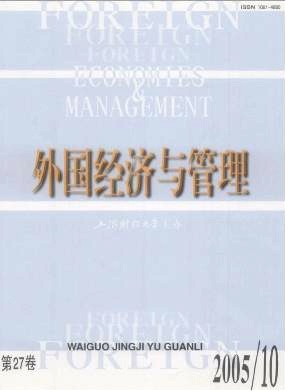国外企业智力资本研究述评
外国经济与管理 2005 年 第 27 卷第 10 期, 页码:
摘要
参考文献
摘要
本文在系统回顾和综合分析国外智力资本思想发展脉络的基础上,对智力资本的概念、构成要素及其价值度量方法等方面进行了比较全面的述评,并通过总结智力资本研究现状,提出了促进我国企业智力资本优化积累的若干建议。
[1]Hayek, F A. The use of knowledge in society[J].American Economic Review, 1945, 35 (4): 519-530.
[2]Machlup, F. The production and distribution of knowledge in the United States[M] NJ: Princeton University Press, 1962: 18-19.
[3]约翰·肯尼思·加尔布雷思.权力的分析[M].石家庄:河北人民出版社,1988.
[4]Itami, Hiroyuki. Mobilizing invisible assets (Thomas W Roehl, Trans. ) [M]. Cambridge: Harvard University Press, 1987: 12-22.
[5]Stewart, T A. Brainpower:how intellectual capital is becoming America's most valuable asset[J]. Fortune, 1991, (6): 40-56.
[6]Stewart, T A. Your company's most valuable asset: intellectual capital [J]. Fortune, 1994, (10): 34-42.
[7]托马斯·A 斯图尔特.“软”资产——从知识到智力资本[M].北京:中信出版社,2003:XII-XIIV,12-18,345.
[8]Ulrich, D. Intellectual capital=competence X commitment [J]. Sloan Management Review, 1998, (win.): 15-26.
[9]安妮·布鲁金.第三资源——智力资本及其管理[M].大连:东北财经大学出版社,1998:13-17.
[10]Edvinsson, L & Malone, M S. Intellectual capital: realizing your company's true value by finding its hidden brainpower [M]. NY: Harper Business, 1997.
[11]Bontis, N. There's a price on your head: managing intellectual capital strategically[J]. Business Quarterly, 1996, 60 (4):40-47.
[12] Sveiby, K E. The intangible assets momtor[J]. Journal of Human Resource Costing and Accounting, 1997, 2(1): 73-97.
[13]帕特里克·沙利文.价值驱动的智力资本[M].北京:华夏出版社,2002:2-10.
[14]Edvinsson, L & Sullivan, P H. Developing a model for management intellectual capital[J]. European Management Journal, 1996,14(4): 356-364.
[15]Kaplan, R S & Norton, DP. Using the balanced scorecard as a strategic management system [J]. Harvard Business Review, 1996, (Jan/Feb): 75-85.
[16]S Wesley Changchien, Pi-Yu Tsai. Measuring return on investment of intellectual capital-ROIC [J]. International Journal of Learning and Intellectual Capital, 2005, 2(3): 219-245.
[17]Bontis,N. Assessing knowledge assets; a review of the models used to measure intellectual eapital[J]. International Journal of Management Reviews, 2001, 3(1):41-60.
[18]Lynn, B. Performance evaluation in the new economy: bringing the measurement and evaluation of intellectual capital into the management planning and control system[J]. International Journal of Technology Management, 1998,10: 171.
[19]Lev, Baruch. Intangibles: management, measurement and reporting [M]. Washington D. C. : the Brookings Institute Press, 2001.
[20]Nonaka, I. The knowledge-creating company [J]. Harvard Business Review, 1991, 69(6): 96-104.
[21]Zollo, M & Winter, S G. Deliberate learning and the evolution of dynamic capabilities[J]. Organization Science, 2002, 13(3): 339-351.
[2]Machlup, F. The production and distribution of knowledge in the United States[M] NJ: Princeton University Press, 1962: 18-19.
[3]约翰·肯尼思·加尔布雷思.权力的分析[M].石家庄:河北人民出版社,1988.
[4]Itami, Hiroyuki. Mobilizing invisible assets (Thomas W Roehl, Trans. ) [M]. Cambridge: Harvard University Press, 1987: 12-22.
[5]Stewart, T A. Brainpower:how intellectual capital is becoming America's most valuable asset[J]. Fortune, 1991, (6): 40-56.
[6]Stewart, T A. Your company's most valuable asset: intellectual capital [J]. Fortune, 1994, (10): 34-42.
[7]托马斯·A 斯图尔特.“软”资产——从知识到智力资本[M].北京:中信出版社,2003:XII-XIIV,12-18,345.
[8]Ulrich, D. Intellectual capital=competence X commitment [J]. Sloan Management Review, 1998, (win.): 15-26.
[9]安妮·布鲁金.第三资源——智力资本及其管理[M].大连:东北财经大学出版社,1998:13-17.
[10]Edvinsson, L & Malone, M S. Intellectual capital: realizing your company's true value by finding its hidden brainpower [M]. NY: Harper Business, 1997.
[11]Bontis, N. There's a price on your head: managing intellectual capital strategically[J]. Business Quarterly, 1996, 60 (4):40-47.
[12] Sveiby, K E. The intangible assets momtor[J]. Journal of Human Resource Costing and Accounting, 1997, 2(1): 73-97.
[13]帕特里克·沙利文.价值驱动的智力资本[M].北京:华夏出版社,2002:2-10.
[14]Edvinsson, L & Sullivan, P H. Developing a model for management intellectual capital[J]. European Management Journal, 1996,14(4): 356-364.
[15]Kaplan, R S & Norton, DP. Using the balanced scorecard as a strategic management system [J]. Harvard Business Review, 1996, (Jan/Feb): 75-85.
[16]S Wesley Changchien, Pi-Yu Tsai. Measuring return on investment of intellectual capital-ROIC [J]. International Journal of Learning and Intellectual Capital, 2005, 2(3): 219-245.
[17]Bontis,N. Assessing knowledge assets; a review of the models used to measure intellectual eapital[J]. International Journal of Management Reviews, 2001, 3(1):41-60.
[18]Lynn, B. Performance evaluation in the new economy: bringing the measurement and evaluation of intellectual capital into the management planning and control system[J]. International Journal of Technology Management, 1998,10: 171.
[19]Lev, Baruch. Intangibles: management, measurement and reporting [M]. Washington D. C. : the Brookings Institute Press, 2001.
[20]Nonaka, I. The knowledge-creating company [J]. Harvard Business Review, 1991, 69(6): 96-104.
[21]Zollo, M & Winter, S G. Deliberate learning and the evolution of dynamic capabilities[J]. Organization Science, 2002, 13(3): 339-351.
引用本文
洪茹燕, 吴晓波. 国外企业智力资本研究述评[J]. 外国经济与管理, 2005, 27(10): 0.
导出参考文献,格式为:
上一篇:国外顾客投诉研究及其启示
下一篇:西方城市蔓延研究综述





 7135
7135  0
0

